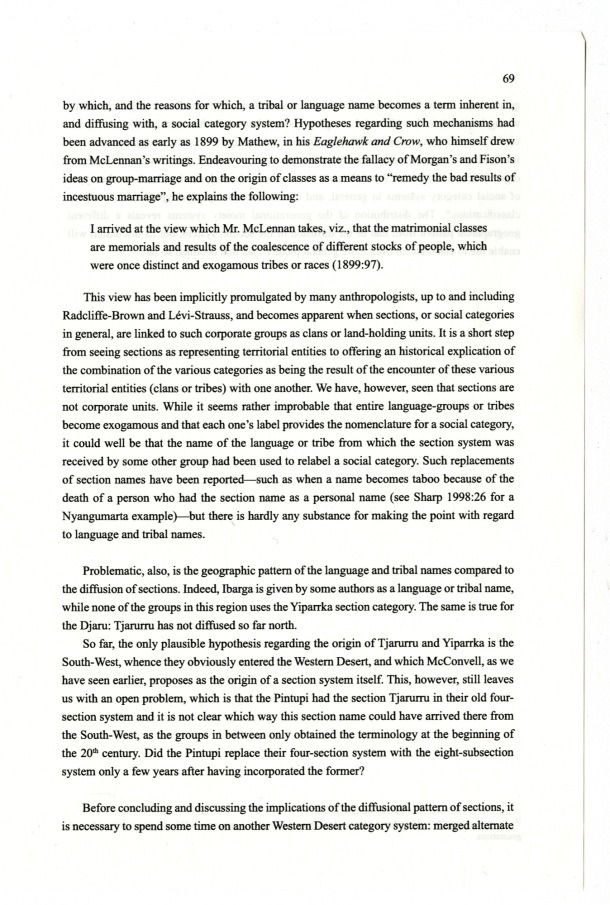|
| 
[Note: this transcription was produced by an automatic OCR engine]
69
by which, and the reasons for which, a tribal or language name becomes a term inherent in,
and difliising with, a social category system? Hypotheses regarding such mechanisms had
been advanced as early as 1899 by Mathew, in his Eaglehawk and Crow, who himself drew
from McLennan’s writings. Endeavouring to demonstrate the fallacy of Morgan’s and Fison’s
ideas on group-marriage and on the origin of classes as a means to “remedy the bad results of
incestuous marriage”, he explains the following:
I arrived at the view which Mr. McLennan takes, viz., that the matrimonial classes
are memorials and results of the coalescence of different stocks of people, which
were once distinct and exogamous tribes or races 1 89997.
This View has been implicitly promulgated by many anthropologists, up to and including
Radcliffe-Brown and Lévi—Strauss, and becomes apparent when sections, or social categories
in general, are linked to such corporate groups as clans or land-holding units. It is a short step
from seeing sections as representing territorial entities to ofiering an historical explication of
the combination of the various categories as being the result of the encounter of these various
territorial entities clans or tribes with one another. We have, however, seen that sections are
not corporate units. While it seems rather improbable that entire language-groups or tribes
become exogamous and that each one’s label provides the nomenclature for a social category,
it could well be that the name of the language or tribe from which the section system was
received by some other group had been used to relabel a social category. Such replacements
of section names have been reported—such as when a name becomes taboo because of the
death of a person who had the section name as a personal name see Sharp 1998226 for a
Nyangumarta example—but there is hardly any substance for making the point with regard
to language and tribal names.
Problematic, also, is the geographic pattern of the language and tribal names compared to
the diffusion of sections. Indeed, Ibarga is given by some authors as a language or tribal name,
while none of the groups in this region uses the Yiparrka section category. The same is true for
the Djaru: Tjarurru has not diffused so far north.
So far, the only plausible hypothesis regarding the origin of Tjarurru and Yiparrka is the
South-West, whence they obviously entered the Western Desert, and which McConvell, as we
have seen earlier, proposes as the origin of a section system itself. This, however, still leaves
us with an open problem, which is that the Pintupi had the section Tjarurru in their old four-
section system and it is not clear which way this section name could have arrived there from
the South-West, as the groups in between only obtained the terminology at the beginning of
the 20"‘ century. Did the Pintupi replace their four-section system with the eight-subsection
system only a few years atter having incorporated the former?
Before concluding and discussing the implications of the diffusional pattern of sections, it
is necessary to spend some time on another Western Desert category system: merged alternate
|